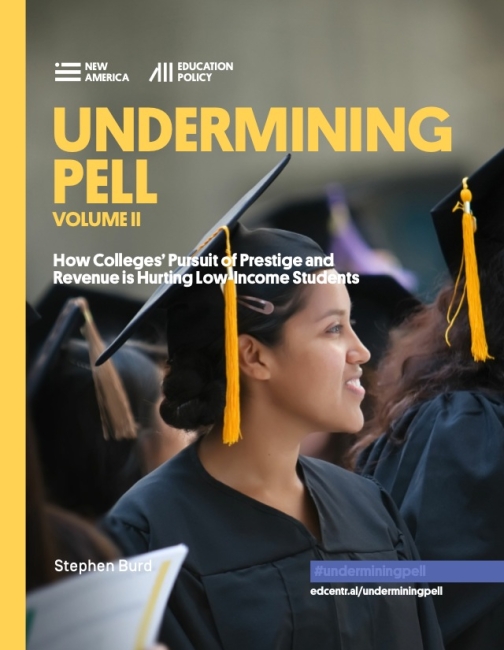You have /5 articles left.
Sign up for a free account or log in.

New America Foundation
Hundreds of colleges charge low-income students tuition that is half or more of their household’s entire yearly income, according to a report released today by the New America Foundation that seeks to shed light on colleges’ aid practices and to prod Congress to change the structure of Pell Grants.
The purpose of Pell Grants, which help about 9 million low-income Americans attend college, is being undermined by many colleges that either are not admitting many Pell recipients or are doing little else to help needy students pay for college costs not covered by Pell, according to New America.
“Worse yet, there is compelling evidence to suggest that many schools are engaged in an elaborate shell game: using Pell Grants to supplant institutional aid they would have otherwise provided to financially needy students, and then shifting these funds to help recruit wealthier students,” according to the report, which was written by Stephen Burd, a senior policy analyst at the Washington think tank. “This is one reason why even after historic increases in Pell Grant funding, low-income students continue to take on heavier debt loads than ever before.”
Report Author on "This Week"
Stephen Burd of the New America Foundation will discuss his new report on aid priorities on Friday's edition of "This Week," Inside Higher Ed's free weekly news podcast. Sign up for notification of "This Week" podcasts here.
Most private and some public colleges offer students huge discounts in the form of need-based aid for low-income students and “merit” aid for students from population groups they would like to enroll. Many higher ed observers, like Burd, are pointing to a shift away from need-based aid to “merit” aid.
“Back in the day, [colleges] used to complement the government’s efforts to make college more accessible, and increasingly they are using their money to get the students they want,” he said in an interview.
In general, colleges doing that want two things: students whose test scores and other credentials will impress U.S. News & World Report -- the magazine whose college ranking formula sets the agenda for administrators at scores of American colleges -- or wealthy students. Colleges will lure wealthier students with modest merit scholarships and still make more off those students than they would off low-income students who received generous need-based scholarships.
“It’s sad,” said Nate Johnson, a higher ed consultant in Florida, “Some of the trends you’re seeing go away from supporting low-income students to going after prestige and revenue. I think it’s hard for some of the colleges to unilaterally disarm and not compete on the same basis as the others without more support from federal and state programs and more incentive to go after [low-income] students.”
Burd's analysis is focused on the actual cost to students of colleges, known as the "net price," which is the cost of tuition, room and board after grants and scholarships. He found 61 private colleges charged tuitions of $25,000 or more to students from homes earning less than $30,000 a year. At least two of those – Saint Joseph’s University in Philadelphia and Catholic University of America in Washington, D.C. – charged more than $30,000 a year to students from low-income households.
David Warren, the president of the National Association of Independent Colleges and Universities, which represents private colleges, said there are "many complex factors that determine the amount of institutional aid given and the net price charged to students."
"Every institution seeks a mix of students by income, interest, talent and background. Institutions have varying resources, academic profiles and even definitions of what is merit- and what is need-based aid," he said in a prepared statement. "We look forward to seeing how the report captures the complexities colleges and universities are navigating to provide aid packages for their students."
Drawing on federal data from the 2011-2012 academic year, the New America report looked at 828 private nonprofit colleges and 598 public colleges, and charted four basic approaches to admitting low-income students. In higher ed policy circles, the number of students on Pell serves as proxy for the number of low-income students on a campus.
One approach is not to admit many low-income students, but to give those that are admitted a lot of institutional aid so they don’t have to take out loans. Harvard University is a perfect example: the lowest-income students at Harvard pay less than $3,000 a year to attend, but only 11 percent of Harvard students come from low-income families.
Other colleges admit a relatively high number of Pell recipients – 15 percent or more – and also manage to keep the prices low, which New American defined as under $10,000 per year.
Vassar College often comes up in conversations about prestigious private colleges that admit a relatively high number of low-income students – 22 percent of its students in fall 2011 – and keeps their annual expenses low, to less than $7,000.
New America’s target is the other two kinds of colleges: those that either don’t admit many Pell recipients or that admit a lot but don’t provide scholarships to help Pell students cover the full cost of college.
Washington University in St. Louis admits a surprisingly few number of low-income students: just 7 percent of its students were on Pell during the period covered by New America’s report.
That’s changing, though, said Provost Holden Thorp.
“It’s a product of decisions we’ve made in the past that we’re now changing course on and a big part of what I came here to work on,” said Thorp, who joined Washington University last summer.
This year, the number of Pell-eligible first-year students at Washington University rose to 8 percent from 6 percent the year before. Thorp said the goal is to get the percentage of Pell recipients to be comparable to that of Washington Unviversity's peers -- in the 12- to 14-percent range.
New America also looked at colleges that admit a large number of Pell students but don't do much to support them with college-funded scholarships.
These colleges tend have smaller endowments and to be dependent on tuition.
“Indeed, it is often the poorest schools that enroll the largest proportion of federal Pell Grant recipients and charge these students high net prices because of their own limited resources,” Burd said in his report.
Burd mostly focused on private colleges, but warned that more and more public universities – in the hunt for rankings prestige or wealthy students to help pay the bills – are also “undermining Pell."
“State disinvestment and institutional status-seeking are working together, hand in hand, to encourage an increasing number of public institutions to adopt the enrollment tactics of their private-college counterparts – often to the detriment of the low-income students they enroll,” he wrote.
New America’s whole report gets to the heart of an effort that New America has undertaken to get Congress to modify Pell as part of the Bill and Melinda Gates Foundation-backed effort to “reimagine” federal aid policy.
In a proposal released last year, New America argued that Congress, which at some point in the near future is supposed to revise its massive bundle of higher education laws, needs to add more strings to Pell. First, New America recommends that colleges be required to match Pell Grants dollar for dollar if they enroll relatively few low-income students and charge a relatively high net price. Second, the think tank recommends that colleges get bonuses from the federal government for ensuring that 25 percent or more of their student population is made up of low-income Pell recipients.
Thorp, the Washington University provost, said he and provosts he meets with would not have a problem with such changes designed to increase the enrollment of Pell recipients.
“I don’t think people would be super concerned about incentives to push the number even higher,” he said.
At Washington University, the Pell Grant covers only a tenth of what the university spends to educate a student. Thorp said the actual money from Pell isn’t as important to the university as what Pell measures: whether or not it is providing opportunities for low-income Americans.




